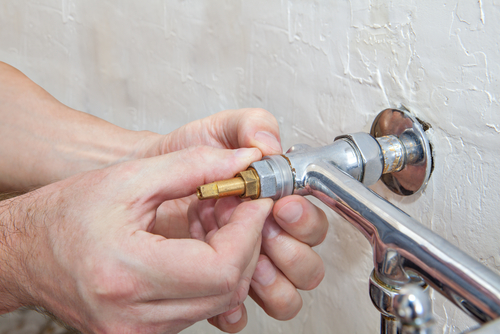What're your ideas regarding 4 Common Reasons for a Leaky Faucet?

Leaking taps might look like a small inconvenience, however their impact surpasses simply the nuisance of the noise. From wasting water to incurring unnecessary financial costs and health and wellness risks, ignoring a trickling tap can cause different consequences. In this write-up, we'll explore why it's important to address this usual home concern without delay and successfully.
Wastage of Water
Environmental Influence
Dripping taps add considerably to water wastefulness. According to the Environmental Protection Agency (EPA), a single tap trickling at one drip per second can lose greater than 3,000 gallons of water per year. This not only stress water resources yet additionally influences communities and wild animals based on them.
Financial Prices
Enhanced Water Expenses
Beyond the environmental effect, leaking faucets can inflate water bills substantially. The built up wastage over time translates into higher energy expenditures, which might have been stayed clear of with prompt repairs.
Prospective Property Damage
In addition, prolonged dripping can bring about damage to fixtures and surfaces bordering the tap. Water buildup can create staining, corrosion, and even structural problems if left ignored, leading to added fixing expenses.
Wellness Issues
Mold and Mold Development
The consistent presence of dampness from a trickling tap creates an optimal atmosphere for mold and mildew and mildew growth. These fungis not only endanger interior air high quality but also pose wellness risks, particularly for people with breathing conditions or allergic reactions.
Waterborne Diseases
Stationary water in leaking faucets can come to be a breeding place for bacteria and various other microorganisms, increasing the threat of waterborne illness. Impurities such as Legionella germs grow in stagnant water, potentially leading to severe illnesses when ingested or breathed in.
DIY vs. Expert Repair
Benefits and drawbacks of Do It Yourself Repair Work
While some might try to fix a leaking tap themselves, do it yourself fixings include their very own set of difficulties. Without appropriate expertise and devices, do it yourself efforts can worsen the problem or bring about incomplete repair services, lengthening the trouble.
Advantages of Employing a Specialist Plumber
Employing a specialist plumber ensures that the underlying root cause of the trickling tap is dealt with effectively. Plumbers have the expertise and tools to identify and fix faucet problems successfully, saving time and reducing the risk of more damages.
Step-by-Step Guide to Repairing a Dripping Faucet
Devices Needed
Before trying to repair a trickling faucet, collect the needed devices, including an adjustable wrench, screwdrivers, substitute components (such as washers or cartridges), and plumber's tape.
Typical Tap Issues and Their Solutions
Recognize the type of tap and the details issue causing the drip. Usual troubles consist of damaged washers, rusty valve seats, or defective O-rings. Describe manufacturer directions or on the internet tutorials for detailed assistance on fixings.
Preventive Measures
Routine Upkeep Tips
To stop dripping faucets, do regular upkeep such as cleaning aerators, examining for leaks, and replacing worn-out parts quickly. Furthermore, think about setting up water-saving gadgets or upgrading to much more efficient components.
Relevance of Prompt Services
Resolving trickling faucets as soon as they're noticed protects against more water waste and potential damages, ultimately conserving both water and money in the future.
Effect On Building Value
Perception of Well-Maintained Building
Preserving a residential or commercial property in good condition, consisting of dealing with upkeep issues like trickling faucets, improves its regarded value and value amongst possible purchasers or tenants.
Influence on Resale Worth
Properties with well-kept plumbing components, including taps, command greater resale worths in the real estate market. Dealing with leaking taps can add to a favorable impact during residential or commercial property assessments and settlements.
Ecological Obligation
Private Payment to Preservation
Taking duty for dealing with trickling taps straightens with wider initiatives toward water conservation and environmental sustainability. Every person's activities jointly make a considerable impact on protecting precious sources.
Sustainable Living Practices
By focusing on punctual repair services and taking on water-saving behaviors, people add to lasting living techniques that benefit both existing and future generations.
Final thought
Addressing a leaking tap goes beyond simple ease; it's a crucial step toward saving water, reducing monetary prices, and securing health and building. Whether with do it yourself fixings or professional assistance, taking action to take care of leaking taps is a small yet impactful method to advertise accountable stewardship of resources and contribute to a healthier, more sustainable future.
How to Fix a Dripping or Leaky Faucet
A leaking faucet is one of the most common problems that homeowners encounter, but it being commonplace doesn’t make it any less annoying. The constant drip drip drip of a leaking bathtub faucet, showerhead, or sink tap can disturb your home’s serenity. Left neglected, a dripping faucet can also result in higher water bills and discoloration or mold growth in your sink or plumbing fixtures.
Fortunately, you don’t have to be a trained plumber to know how to stop a dripping faucet. With some basic tools, replacement parts, and a little patience, leaky faucet repair is a breeze. In this article, we’ll explain what causes dripping faucets and how you can fix them.
What Causes a Leaking Faucet?
Kitchen and bathroom faucets come in all manner of designs, but most involve some combination of valves, O-rings, seals, and washers. The O-ring is usually the weakest link, but any one of these pieces can wear down over time. Heat, moisture, temperature fluctuations, minerals, mold, and movement can contribute to warping and corrosion, breaking the watertight seal. This just comes with the territory of being a homeowner. Everything is always subject to wear and tear, and some component parts of your appliances and fixtures need to be replaced on occasion. At least replacement O-rings are cheap!
More rarely, dripping faucets can be a symptom of excessively high water pressure. Were this the case in your home, you would probably notice that the leak is not isolated to one faucet. Water pressure issues are harder to resolve on your own. We recommend contacting a professional plumber if you suspect your water pressure is too high.
How to Fix a Dripping Faucet
Pipe wrench or monkey wrench Allen wrench set Screwdrivers Old towel or rag Shut off the water.
Before you do anything, you need to turn off the water to keep from drenching your kitchen or bathroom. You should find a valve under the sink and against the wall. Once you’ve turned this valve, try turning the faucet on to confirm that the water source has been cut off.
If you can’t locate your local valve for the faucet you’re working on, you can always shut off the water to the house at the main valve. Of course, this will prohibit anyone from using the sinks, showers, or toilets while you’re working on the faucet that’s giving you trouble.
Plug or block the drain.
You’ll be disassembling the faucet and removing some small bits of hardware. Plug the drain with a stopper or rag to avoid the possibility of a small screw falling into your P-trap.
Take apart the faucet assembly.
There are several varieties of kitchen and bathroom faucets, each with its own manner of assembly. For detailed instructions on how to disassemble your faucet, you can refer to the fixture’s manual or contact the manufacturer. If you know whether you have a ball, disc, cartridge, or compression faucet, you can find detailed schematics online.
In general, you need to begin by removing the faucet handles. You might notice a small screw that you’ll need to remove with a screwdriver or Allen wrench. If you don’t see any visible securing hardware, it’s likely hidden under a decorative cap that can be unscrewed or popped off with flathead screwdriver.
Remove each piece methodically, consulting a schematic when necessary. Take notes or arrange the pieces in such a way to make it easier to correctly reassemble the faucet later.
Remove the cartridge.
Once you’ve removed the handles and securing hardware, you should be able to remove the valve cartridge or stem. Some cartridges will slide right out. Other faucet models will require you to loosen a nut with a pipe wrench before you can remove the valve stem.
Examine the exposed hardware.
With the cartridge or stem removed, inspect the component parts. Check the rubber O-rings for wear and tear. Also examine the seat washer for corrosion or other damage. These pieces are usually the responsible parties for a dripping faucet, but it’s worth inspecting the other component parts while you have the faucet disassembled.
Find replacement parts.
Once you’ve identified which faucet component has failed, find an identical replacement. Your local hardware store should have O-rings, seat washers, and other standard components in stock. If you have a luxury or uncommon faucet, you may have to contact the manufacturer for a replacement part.
It’s a good idea to take your old parts with you to the hardware store so you can compare them with the store’s inventory and be sure you’re purchasing the correct replacement.
Reassemble the faucet.
With your new parts in hand, reconstruct the faucet and handles. Don’t be tempted to overtighten screws or nuts. You might think this could create a better seal, but it can instead damage or bend a delicate part of the assembly and create a new problem for you.
Turn on the water and test the faucet.
The only thing left to do is test your work. Unplug the sink, turn the water back on, and try the faucet. Congratulate yourself on a job well done!
https://www.libertyhomeguard.com/how-to-fix-a-dripping-or-leaky-faucet/

We had been made aware of that report on Leaky Faucets: Why They Happen & What to Do About Them from an acquaintance on another blog. Enjoyed our entry? Please quickly share it. Help another person discover it. I praise you for being here. Please visit our site back soon.